The Social Security Statement: Background, Implementation, and Recent Developments
Social Security Bulletin, Vol. 74, No. 2, 2014 (released May 2014)
This article provides the first comprehensive description of the substantial effort and resources involved in developing and implementing the annual earnings and benefit statement that the Social Security Administration (SSA) began mailing in 2000 to all workers aged 25 or older. Details about the statement's background and implementation should be useful to researchers studying the statement's effect on workers' retirement decisions and knowledge of the program. The article also describes the suspension of the printed version of the statement in March 2011 to conserve agency funds, the launch of the online statement in May 2012, various efforts to reinstate statement mailings, and the decision to resume mailings to workers of selected ages beginning in September 2014. The article concludes by describing changes in the statement's appearance and content, the statement's relationship to SSA's strategic plans, and the surveys SSA commissioned to measure public awareness and knowledge of Social Security.
Barbara A. Smith is with the Office of Policy Research, Office of Retirement Policy, Social Security Administration. Kenneth A. Couch is a professor of labor economics at the University of Connecticut.
Acknowledgments: The authors are indebted to Beatrice Dubin and Angela Jaffee, for providing much of the background material for this article; to Phil Gambino, Patricia Martin, John Phillips, and David Weaver, for their thoughtful and substantive comments and suggestions; and to Larry DeWitt, Joann Sim, and Rusty Toler, who contributed in both regards.
Contents of this publication are not copyrighted; any items may be reprinted, but citation of the Social Security Bulletin as the source is requested. The findings and conclusions presented in the Bulletin are those of the authors and do not necessarily represent the views of the Social Security Administration.
Introduction
| OBRA | Omnibus Budget Reconciliation Act |
| PEBES | Personal Earnings and Benefit Estimate Statement |
| SSA | Social Security Administration |
In 1995, the Social Security Administration (SSA) began mailing annual earnings and benefit statements to workers in selected age groups. The purpose of these statements is threefold: to inform workers about their Social Security benefits, to help workers plan for their financial future, and to ensure that workers' earnings records are accurate. Initially, the statement was known as the Personal Earnings and Benefit Estimate Statement (PEBES) and was sent only to workers nearing retirement. By 2000, it was renamed the Social Security Statement (or, simply, the Statement) and sent to all workers aged 25 or older.1 It was the largest customized mailing ever undertaken by a federal agency (SSA n.d. a).
Although the statement represented a historic effort and required substantial resources and manpower, no comprehensive description of its development and implementation exists. This article provides such a description (along with the statement's implementation schedule), which may be useful to researchers studying the statement's effect on workers' retirement decisions and knowledge of the program.
The article first describes SSA's initiatives to inform individuals about their earnings and benefits before Congress mandated an automatically issued statement. It then presents the statement's implementation schedule, as included in the authorizing legislation and as modified by SSA. It describes how the agency phased in automatic mailings and how it responded to budgetary constraints by suspending the mailing of the printed version of the statement in 2011 and launching an online version in 2012.2 It also discusses the agency's decision to resume mailing the Statement to workers of selected ages in 2014. The article next describes how the statement's content and appearance have changed, and how the statement relates to SSA's strategic plans. It concludes by highlighting findings of the surveys SSA commissioned to measure public knowledge and understanding of Social Security and of the Statement itself. Appendices present a chronology summarizing the statement's history along with samples of the Statement and accompanying inserts.
Background
Although the statement brought earnings and benefits information directly to workers, access to earnings records had been available to workers since soon after the program began in 1935. The Social Security Act Amendments of 1939 stated that the Social Security Board (precursor to SSA) “shall establish and maintain records of the amounts of wages paid to each individual…and, upon request, shall inform any individual…of the amounts of wages of such individual and the periods of payments shown by such records at the time of such request.”3 On October 8, 1940, the Social Security Board established regulations governing, among other things, the revision of wage records by individuals (SSA n.d. c).4
As a result, individuals were able to review and, where necessary, initiate corrections to their earnings records. Individuals desiring to review their earnings records would visit a local field office and fill out the postcard-sized Wage Statement Request form, providing information including Social Security number and date of birth. Upon receiving the form, SSA would mail a copy of the worker's earnings history to the address listed on the postcard. If there were any discrepancies between the SSA earnings record and the worker's personal records, the worker could visit the local SSA field office with the appropriate information—such as W-2 forms, old pay stubs, or other documentation from an employer—to correct the errors (SSAB 2009).
From the 1960s to the early 1980s, SSA considered, and in some cases implemented, programs to provide more information to workers about their benefits. In May 1962, SSA initiated the “leads” program, which involved sending letters to older insured workers who had not yet claimed benefits, to inform them of their entitlement to benefits (SSA n.d. d). Throughout the 1970s and into the early 1980s, SSA considered initiatives that would—individually or in various combinations—provide benefit estimates as well as earnings statements, provide statements to all workers instead of only those approaching retirement age, and send statements automatically instead of only upon request (SSA 1994). However, the agency was concerned about the feasibility of such initiatives, which would break with the SSA tradition of providing benefit estimates only to those approaching benefit eligibility, and of doing so in the individualized setting of a Social Security office visit. Additionally, estimated future benefit amounts for younger workers could vary significantly from the actual amounts they would eventually receive. Finally, at that time, SSA did not have addresses for workers currently contributing payroll or self-employment taxes, making automatic mailings impossible. In the early 1980s, SSA sent benefit estimates to workers who requested them. However, because this service was not widely publicized, less than 2 percent of payroll taxpaying workers requested a benefit statement (SSAB 2009).
Meanwhile, interest grew outside the agency in having SSA provide workers with information about their Social Security benefits. For example, the National Commission on Social Security, appointed by President Carter pursuant to the 1977 Social Security Amendments, recommended in its 1981 final report that SSA provide Social Security benefit “illustrations” to workers requesting them.5 The report added that distributing these benefit illustrations automatically to all covered workers would be desirable (SSA 1994).6 On Capitol Hill, Senator Daniel Patrick Moynihan (D–NY) began suggesting in the 1980s that SSA send workers information on the Social Security benefits they could expect to receive.7
In 1988, interest converged from both inside and outside SSA in providing workers with information on their benefits. On August 4th, Senator Moynihan introduced S. 2684, a bill mandating that SSA issue earnings and benefit statements. That same day, Commissioner Dorcas R. Hardy announced that SSA would begin providing the PEBES on request.8 The PEBES provided workers with their earnings history; the amount of Social Security taxes they paid; estimates of the benefits they would receive at the early retirement age (62), the full retirement age, and age 70; estimates of disability and survivors benefits; and descriptions of maximum earnings subject to Social Security taxes, Social Security tax rates, Social Security credits, credits for military and railroad service, and how benefit estimates were calculated.
No further action was taken on S. 2684. In January and June of 1989, Senator Moynihan again introduced bills mandating that SSA issue earnings and benefit statements to workers. Although no action was taken on these bills, language from the June bill was inserted into the Omnibus Budget and Reconciliation Act (OBRA) of 1989, presumably by Senator Moynihan.9
Senator Moynihan expressed the rationale for this mandate when he introduced S. 212 in January 1989: “All of us pay into Social Security but rarely, until we become beneficiaries, do we ever hear from Social Security…every month, in every paycheck, we see money withheld for Social Security, but we hear nary a word from the Social Security Administration. Let us take this simple step [sending statements] to reassure Americans that Social Security will be there for them” (U.S. Congress 1989, S620). Inserting language from Senator Moynihan's bill into OBRA 1989 ensured that workers would receive regular information on their Social Security benefits.
OBRA 1989 amended the Social Security Act to require SSA to issue what the legislation referred to as Social Security account statements according to the following schedule:
- Phase 1. Beginning no later than October 1, 1990, statements would be sent on request to eligible individuals.10
- Phase 2. No later than September 30, 1995, statements would be sent automatically to each eligible individual who had attained age 60 by October 1, 1994, who was not receiving benefits under Title II, and for whom a current mailing address could be determined.11 In fiscal years 1995 through 1999, statements would be sent to each individual meeting those criteria and attaining age 60 during the year.
- Phase 3. Beginning no later than October 1, 1999, biennial statements would be sent automatically to eligible individuals who were not receiving benefits under Title II and for whom a mailing address could be determined. For individuals younger than age 50, a general description of benefits, but no actual benefit estimates, would be required.12
OBRA 1989 also specified that these statements contain the same information provided in the on-request PEBES: the worker's earnings history; estimated Social Security and Medicare taxes paid; estimates of potential retirement, disability, survivors, and auxiliary benefits payable; plus a description of benefits payable under Medicare. In addition, the legislation required SSA to take “such steps as are necessary to assure that eligible individuals are informed of the availability of the statement.”
Statement Phase-in
When OBRA 1989 was passed, SSA was already implementing Phase 1. As noted earlier, SSA had begun providing PEBES, on request, in August 1988. Implementing Phases 2 and 3, however, required more planning and preparation.
Based on the language in the legislation, SSA estimated that the following number of statements would be mailed out during Phases 2 and 3 (Enoff n.d.):
| Fiscal year | Number to be issued | Recipient ages |
|---|---|---|
| 1995 | 6.7 million | 60 or older |
| 1996 | 1.6 million | 60 |
| 1997 | 1.7 million | 60 |
| 1998 | 1.8 million | 60 |
| 1999 | 1.8 million | 60 |
| 2000 | 123.0 million | 25 or older |
| 2001 and later | 123+ million each year | 25 or older |
According to the legislation, mailings in fiscal year 1995 would be sent to all individuals aged 60 or older and not yet receiving benefits. In each fiscal year 1996 through 1999, mailings would be sent only to those individuals attaining age 60. In fiscal year 2000, mailings would include initial statements to individuals between ages 25 and 60 and second (or first annual) statements to those individuals older than 60 who had received initial statements in fiscal years 1995 through 1999. In fiscal year 2001 and subsequent years, mailings would include annual statements to individuals older than 25 and initial statements to individuals reaching age 25 in that year. SSA estimated that for several years after fiscal year 2001, the number of new 25-year-olds would exceed the number of older individuals becoming beneficiaries and no longer requiring statements. Thus, SSA projected the number of PEBES recipients would increase during those years (Enoff n.d.).
After reviewing OBRA 1989, SSA modified several specifications, going beyond the legislative requirements. For example, SSA decided to provide projected benefit estimates to all eligible workers and not just to those aged 50 or older (SSAB 2009). SSA also decided to modify the mailing schedule so that statements would be sent to increasingly younger age groups during fiscal years 1996–1999.13 Thus, the number of annual PEBES mailings increased gradually rather than jumping from approximately 1.8 million for fiscal year 1999 to 123 million in fiscal year 2000 (SSA n.d. a).
Sending out more than 123 million statements is an enormous undertaking. Understandably, SSA was concerned about the resources required to send the statements automatically. In addition to the mechanisms involved with the actual mailing, SSA needed to estimate the number of requests for information or for corrections to earnings errors that might result from these mailings so that it could set up procedures to handle them. SSA also needed to arrange with the Internal Revenue Service and other agencies to get the required mailing addresses.
After many internal discussions, SSA decided to phase in the annual automatic PEBES by expanding and enhancing the existing procedure for producing the on-request PEBES. SSA would identify those individuals eligible to receive an automatic statement using its Social Security number database. The agency would procure addresses for these eligible individuals through reimbursable agreements with the Internal Revenue Service and the taxation agencies in Puerto Rico, Guam, and the U.S. Virgin Islands. SSA, using in-house system processing, would then produce information on individuals' earnings and calculate both the credits of coverage and the full range of benefit estimates. These data would be provided to a commercial vendor, who would print and mail the statements (Enoff n.d.).
A major concern for SSA was the potentially large number of general inquiries and earnings-record correction requests once PEBES was sent annually to all eligible recipients aged 25 or older. Responding to these inquiries and requests is very labor-intensive. Based on a preliminary survey, SSA estimated that for initial PEBES mailings in fiscal year 1995, the agency could expect 174,870 inquiries (2.6 percent of recipients) and 150,750 earnings-correction requests (2.3 percent). SSA estimated that handling this number of contacts would take about 900 work-years (Enoff n.d.).14
In 1994, SSA test-mailed about 600,000 PEBESs nationwide in order to analyze the number and types of inquiries received and plan for future PEBES-related workloads (Chater 1994). About 16,000 recipients also received a questionnaire asking for their reaction to receiving the PEBES form, and to its language and design. SSA also commissioned a series of focus groups for additional public input on PEBES language and design.
The transition from on-demand to automatic annual earnings and benefit statements required reorganization within SSA. When PEBES was sent only on request, the Office of Earnings Operations (OEO) corrected all earnings errors. With the move to automatically issued statements, error-correction capability expanded to other SSA components, including field offices, program service centers, and teleservice centers (SSA n.d. a). Similarly, when PEBES was only sent on request, inquiries were handled through the OEO toll-free number. However, OEO did not have the capacity to handle the volume of inquiries expected once the PEBES was issued automatically. Thus, SSA decided to use its National 800 Number Network to handle PEBES inquiries.15
SSA began automatic issuance of earnings and benefit statements in 1995, using the PEBES format.16 SSA redesigned the form and renamed it the Social Security Statement in October 1999. Shown below is the final implementation schedule.
| Fiscal year | Number issued a | Recipient ages |
|---|---|---|
| 1995 | 7.0 million | 60 or older |
| 1996 | 5.5 million | 58–60 |
| 1997 | 12.4 million | 53–58 |
| 1998 | 20.7 million | 47–53 |
| 1999 | 26.6 million | 40–47 |
| 2000 | 134.7 million | 25 or older |
| 2001 | 135.6 million | 25 or older |
| 2002 | 137.9 million | 25 or older |
| a. For fiscal years 1989 through 1995, PEBESs were only sent on request, and SSA received about 3.5 million requests per year. This request volume continued through fiscal year 2000, when SSA began sending the Social Security Statement to all workers aged 25 or older. Requests declined to 1 million in fiscal year 2001 and to 780,000 in fiscal year 2002. | ||
SSA staggered the Social Security Statement mailings throughout the year. In fiscal year 2010, SSA sent over 151 million Statements, which equates to over 12.5 million mailed every month, or about 415,000 each day.17 Workers received their Statements about 3 months before their birthday (SSA n.d. a).
SSA also sent special age-targeted inserts with the Statements. Beginning in October 2000, the first such insert, Thinking of retiring?, was sent to individuals aged 55 or older. It contained information about the effects of claiming Social Security benefits at age 62, at full retirement age, or at age 70, and the effects of working after claiming benefits—and the implications of each option for the beneficiary and for the beneficiary's survivors. The insert also contained information on applying for Medicare, and listed websites and phone numbers providing more information about Social Security benefits, retirement planning, investment options, and housing and health issues. Appendix B presents a facsimile insert.
In February 2009, SSA began sending an insert to workers aged 25 to 35, What young workers should know about Social Security and saving (see Appendix C). This insert described the future finances of Social Security, the nonretirement benefits provided by Social Security (such as disability and survivor benefits), and the importance of saving to supplement Social Security benefits. It also listed websites providing information about saving and investing.
Recent Developments
On March 29, 2011, after several years of increasing budget constraints, SSA suspended Statement mailings in order to conserve funds.18 Shortly thereafter, the agency established an internal workgroup to develop an online version of the Statement that would be easily and securely accessible to the public.
The Online Statement Workgroup included representatives from each of the relevant offices in SSA. Operating under a tight deadline, the workgroup developed the online Statement, created a robust authentication process to prevent unauthorized access to workers' personal information, and tested and validated both the Statement and the authentication process. For the authentication process, the agency reached out to privacy experts and advocacy groups for input on the best available methods to protect personal information in an electronic environment.
On May 1, 2012, SSA launched a secure and easy-to-use online version of the Statement to provide workers with immediate access to their earnings records, estimated benefits, and related information. Whereas the print version was mailed only to eligible workers aged 25 or older, the online Statement was and continues to be available to all individuals aged 18 or older.19 The online Statement includes links to important information, such as an insert for workers aged 55 or older, and to other online services and tools. In the first week after its launch, more than 130,000 individuals visited the SSA website and viewed their online Statements (SSA 2012d). Online Statements had been viewed by 1 million visitors in less than two months (SSA 2012a) and by nearly 3 million visitors as of the end of September 2012.20 In fiscal year 2013, online Statements were viewed 16.9 million times, of which 7.1 million were unique visits—meaning that, on average, each visitor viewed his or her Statement about 2.4 times during the year. In October 2013, 1.7 million visitors viewed their online Statements; assuming similar usage throughout fiscal year 2014, SSA projects that online Statements will total more than 20 million visitors.
The status of the printed Statement also changed several times during 2012. SSA resumed targeted mailings on February 15, 2012, sending printed Statements to approximately 11.4 million eligible workers aged 60 or older (SSA 2012b). Then, on July 23, SSA resumed first-time mailings to eligible workers aged 25, sending about 1 million Statements to such recipients. However, on October 1, 2012, in response to an increasingly difficult budget situation, the agency suspended all Statement mailings, including on-request mailings.21
A Joint Explanatory Statement to the Consolidated Appropriations Act of 2014 directed SSA to “develop a plan to significantly increase the number of individuals receiving Social Security Statements annually, either electronically or by mail” (U.S. Congress 2014). The agency responded by establishing a workgroup to determine which workers would receive printed Statements, how often they would be sent, and the most effective printing and mailing procedures. In April 2014, SSA announced that it would begin mailing printed Statements in September to workers aged 25, 30, 35, 40, 45, 50, 55, and 60 or older who have not by then created a my Social Security account to access the Statement online. This partial restoration of mailed Statements was made possible by an improved budget situation.
Statement Content and Appearance
This section describes the statement's substance and layout, and traces how it has changed since the initial PEBES release. Appendix D presents a sample of the Statement as it appeared in 2012, when SSA last suspended automatic mailings. The 2012 Statement retained the basic format that had been used since 2000. Changes introduced for the 2014 Statement appear in Appendices E, F, and G.
Content
Legislation determines the basic content of the earnings and benefit statements. As noted earlier, OBRA 1989 specified that statements contain the worker's earnings history; the Social Security and Medicare taxes paid by the worker; an estimate of potential retirement benefits at the early retirement age of 62, at the full retirement age, and at age 70; estimates of disability, survivor, and auxiliary benefits potentially payable on the worker's account; and a description of benefits payable under Medicare.
Originally, PEBES' first page contained a message from the SSA commissioner. The second page provided information on the worker's earnings and on Social Security and Medicare taxes paid. The third page contained the worker's estimated retirement, disability, and survivor benefits, as well as a description of Medicare benefits. The fourth, fifth, and sixth pages provided additional information on the worker's earnings record, Social Security taxes paid, Social Security and Medicare credits, estimation of benefits, types of benefits, and the effect of working while receiving benefits.
SSA added content to the statements in 1999 and in 2006. On October 1, 1999, when SSA began sending statements to all eligible workers aged 25 or older, a new paragraph encouraged the recipient to think about the advantages and disadvantages of retiring early. A list of publications on topics related to retirement benefits also appeared. Estimated retirement, disability, and survivor benefits (and related information) now appeared before the worker's earnings history. Finally, the commissioner's message, presenting introductory information on the first page of the statement, began to appear under the title “What Social Security Means To You.”
The Social Security Protection Act of 2004 mandated the addition of sections on the Windfall Elimination Provision (WEP) and the Government Pension Offset (GPO) to the Statement beginning in 2007.22 Other changes to the Statement included adding the agency's website address to the first page and expanding the discussion of how benefits are calculated.
The commissioner's introductory message varies in length, language, and content from year to year. As might be expected, the message changes to reflect the environment Social Security faces. In 1988, Commissioner Hardy noted that Social Security provided more than retirement benefits, but those retirement benefits needed supplementation with savings, private pensions, other insurance, and investments. Commissioner Hardy concluded her message by saying that Social Security was financially sound.
In her 1996 message, Commissioner Shirley S. Chater expressed some concern about Social Security's future financial condition. Like Commissioner Hardy, she pointed out that Social Security provides benefits besides those for retirees, and encouraged individuals to establish other retirement savings to supplement Social Security benefits. Commissioner Chater noted that the Social Security Board of Trustees projected that trust fund resources would be adequate to pay benefits in full for more than 30 years. She added that Congress had time to make necessary changes to ensure Social Security's financial future.
Commissioner Kenneth Apfel focused more pointedly on Social Security's financial future. In his October 1, 1998 message, he wrote, “Some people are concerned that Social Security will not be there in the future,” and added “we are working to resolve long-run financing issues.” Commissioner Apfel's message in the October 1, 1999 Statement, the first annual statement, contained subsections titled “Social Security is for People of All Ages,” “Work to Build a Secure Future,” and “About Social Security's Future.” This last subsection noted that concern for the future of Social Security stemmed from longer life expectancies, increasing numbers of retirees, and fewer workers supporting each retiree.
In 2000, Commissioner Apfel added statistics to his discussion of Social Security's future. He noted that 76 million baby boomers would begin retiring around 2010; in the next 30 years, the number of older Americans would double; in 2014, Social Security benefits paid would exceed taxes collected; and by 2034, the trust funds would be exhausted and payroll tax collections would be able to pay for only about 71 percent of benefits owed. Commissioner Apfel also recommended that Statement recipients ask for a copy of SSA's booklet, The Future of Social Security.
In 2001, Acting Commissioner Larry G. Massanari added a fourth subsection, “Social Security on the Net,” to his message. It described how readers could use the agency's website (http://www.socialsecurity.gov) to estimate their future benefits and plan their financial future, apply for retirement benefits, subscribe to eNews for program and benefit updates, correct or change their name on their Social Security card, or get a replacement card.23
In 2003, Commissioner Jo Anne B. Barnhart observed that the number of Americans aged 65 or older was expected to double by the time the Social Security Trust Fund was projected to be exhausted. Commissioner Barnhart also noted that current Social Security benefits were paid by current workers, but that in the future there would not be enough younger workers to pay all of the benefits owed to retirees. Language from previous messages was changed in small but significant ways. To sentences addressing the trust fund's future, the 2003 message added phrases such as “unless action is taken soon to strengthen Social Security.” To an existing passage reading “we'll need to resolve long-range financial issues” the 2003 message added “soon.” Commissioner Barnhart also noted for the first time that trust fund solvency estimates came from SSA's actuaries.
Although Commissioner Michael J. Astrue shortened the overall message in 2007, he added information on saving and investing to the “Work to Build a Secure Future” section. “About Social Security's Future” was condensed: It now provided information about Social Security being a compact between generations, the dates when benefit payments would first be drawn from the trust fund and when the trust fund would be exhausted, and the percentage of scheduled benefits that would be paid after trust fund exhaustion. The phrases introduced by Commissioner Barnhart, noted above, were dropped.
For the September 2014 reintroduction of Statement mailings to workers of selected ages, different versions of the first page were created to incorporate current Acting Commissioner Carolyn W. Colvin's messages for younger workers, midcareer workers, and workers nearing retirement. Although their messages differ in order to focus on issues relevant to a particular age group, the new first pages also include common elements, including remarks promoting the online Statement and highlighting the agency's presence on Facebook, Twitter, and YouTube. In addition, an estimate of the recipient's full retirement benefit appears prominently in all versions of the new first page. These changes will also migrate to the online Statement. Appendices E, F, and G provide examples of the new first pages for younger, midcareer, and older workers, respectively. Further changes to the Statement are planned for fiscal year 2015.
Appearance
The style, design, and layout of the first PEBES, issued in 1988, were created by what was then known as the Office of Information, part of SSA's Office of Governmental Affairs.24 PEBES was six pages long. The second page contained seven columns of numbers. The first column listed each year in the individual's work history; it was followed by three columns each for Social Security and Medicare, showing maximum taxable earnings, the individual's reported earnings, and estimated taxes paid. All other pages contained single-column text.
The first Social Security Statement, issued October 1, 1999, reflected significant, focus group-tested design changes. The Statement was shortened from six to four pages, and the order of presentation changed so that information on benefits preceded information on earnings. Only two columns of numbers, representing taxed Social Security earnings and taxed Medicare earnings, were shown for each year in a worker's earnings history. The numbers now filled only one-half page, instead of one entire page as before. The Statement eliminated information on taxes paid in each earnings year, and now only provided cumulative lifetime Social Security and Medicare taxes paid. Most pages now had two columns of text rather than one. More white space, and greater use of different font sizes and styles, made the Statement easier to read.
The appearance of the Statement changed again with its online incarnation. Although the online Statement's primary features—the Commissioner's message about Social Security and the worker's estimated benefits and earnings record—are presented in the same order as on the print Statement, related content is accessible through links. For example, the online Statement's estimated benefits section provides links to information on Social Security and Medicare, things to consider before deciding to retire, and SSA publications and contacts—content that appears on the last page of the print Statement under “Some Facts about Social Security.” Additionally, for workers in the 25–35 and 55 or older age groups, the estimated benefits section includes a link to the appropriate Statement insert.25 While logged into his or her password-protected my Social Security account, any individual can also opt to view (and print) the Statement.
The September 2014 resumption of Statement mailings brings design changes to the first page of both the print and online versions. The new first page incorporates design features such as graphics, more white space, and larger print. Initially, the Statement will be printed in black and white only. These new design features will appear first in the print version and then in the online Statement.
The Statement's Relationship with SSA's Strategic Plans
SSA's strategic plans not only acknowledge the importance of informing the public about Social Security benefits, they specifically mention the statement.
1991 Plan
The Social Security Strategic Plan: A Framework for the Future, issued in September 1991, noted the significance of legislation mandating SSA to begin, in fiscal year 1995, sending personal earnings and estimated benefit statements automatically.26 One of the three fundamental goals of the 1991 plan was to “instill public confidence in Social Security programs” through the provision of information to “workers and their families to make them aware of their protections under the Social Security programs and the role of Social Security in their financial future.” The 1991 strategic plan underscored the importance of a well-informed public:
Public understanding of the Social Security programs and their importance to society is basic to ensuring that the programs continue to address the social needs they were designed to address. Understanding the types of circumstances in which benefits are payable and having a general sense of benefit levels provide a context for people to plan for retirement financing and other insurance and income-supplement needs…A critical function of SSA is to make every effort to see that people are informed of their eligibility for the benefits we administer (HHS 1991).
1997 Plan
The importance of public understanding of Social Security programs was also a theme of SSA's Strategic Plan 1997–2002: Keeping the Promise, issued in September 1997. One of the five goals of this strategic plan was “to strengthen public understanding of the Social Security programs.” The plan discussed the importance of this goal:
One of SSA's basic responsibilities to the public is to ensure that they understand the benefits available under the Social Security programs to them individually and to the population as a whole. This enables people to make reasonable and responsible choices as they plan for their own future and as they help the nation's leaders make decisions about the future of society (SSA 1997).
The plan stated that SSA would attain this goal if “by 2005, 9 out of 10 Americans will be knowledgeable about the Social Security programs in five important areas: basic program facts, financial value of programs to individuals, economic and social impact of the programs, how the programs are financed today, and financing issues and options.” The plan acknowledged the need for better ways to assess meeting this goal than merely counting the number of PEBES mailings or the percentage of individuals believing they are well informed about Social Security. SSA intended “to create a measure of the percent of individuals who are knowledgeable in each of the five subject areas as demonstrated by responses to an objective test.” To be measured, “knowledgeable” would need to be defined for each of the subject areas. Further, a testing instrument would be needed to establish a baseline knowledge level (SSA 1997).
Meeting this goal would involve developing an overall public education strategy using the media, SSA publications, schools, other public and private organizations, employers and employees, and celebrity spokespersons. PEBES would also play an important role: “PEBES issuance will remain a central strategy for helping SSA maintain the accuracy of earnings records, keeping wage earners up-to-date on their protection under Social Security, and helping wage earners, through an estimate of their future benefits, plan their financial future” (SSA 1997).
In 1998, SSA established the Public Understanding and Management System, an initiative under which six surveys were conducted between 1998 and 2004 to measure public understanding of the Social Security program and benefits. These surveys were designed to measure the effect of the broad public education strategy that included the statement. The next section discusses the surveys and their findings.
2000 Plan
Just as in the 1997 strategic plan, one of the five goals in Mastering the Challenge: Strategic Plan FY2000–2005 was “to strengthen the public understanding of Social Security programs.” The objective remained the same—that by 2005, 9 out of 10 American adults would be knowledgeable about Social Security. However, now the agency focused on improving public knowledge in three areas it deemed especially important: basic program facts, value of Social Security programs, and financing of Social Security programs. This was to be achieved by promoting awareness of the Statement and how it could be used to plan a secure financial future. Performance indicators mentioned in the plan included the percentage of the public who were knowledgeable about Social Security programs and the percentage of individuals to whom Statements were issued, as required by law (SSA 2000).
2008 Plan
The importance of public understanding of Social Security programs remained a theme in SSA's Strategic Plan Fiscal Years 2008–2013. That plan acknowledged that SSA faced “limited public understanding of the role of Social Security benefits” and included an objective to “provide individuals with accurate, clear, up-to-date information.” It also noted that 147 million Statements were issued in fiscal year 2007. The plan contained a special initiative to encourage saving and mentioned the Statement as an important way to provide age-specific information useful for retirement planning. This initiative cited research showing the importance of information and awareness in improving attitudes toward saving and expanding participation in retirement savings plans, and showing that many individuals lack this information and awareness. According to that special initiative, “the agency has a responsibility to help individuals understand the role of Social Security benefits and the need for them to save as they plan for the future” (SSA 2008).
2014 Plan
In Always Serving / Forward Looking: Strategic Plan Fiscal Years 2014–2018, the agency's focus for the Social Security Statement shifted. In this strategic plan, the agency mentions the online Statement as part of its suite of online services and encourages the public to review the Statement to ensure that their earnings are accurate (SSA 2014).
The Statement's Effect on Public Awareness
This section highlights the findings of surveys commissioned by SSA to assess both the public's understanding of Social Security programs and the Statement's effect on that understanding. In response to the 1997 strategic plan's public awareness objective (noted above), SSA commissioned the Gallup Organization to conduct six surveys between 1998 and 2004. SSA also commissioned Abt SRBI to conduct surveys specifically on the Social Security Statement each year 2008–2010. With these surveys, SSA sought to monitor and improve public understanding of the Statement messages.
Gallup Surveys
The first survey, in 1998, was a baseline study to determine what the public knew about Social Security. It found Americans relatively well informed about basic program facts. Respondents recognized the three primary benefit programs (retirement, disability, and survivor insurance); they understood the tax used to support Social Security; they knew how these taxes were being used and how benefits are calculated; and they understood the challenges to long-term program finances posed by an aging population. However, they were less informed about specific program facts: Only 38 percent knew that the full retirement age in 1998 was 65, and only 46 percent knew that the early retirement age was 62. Those who stated they had received a PEBES were better informed than those who did not recall receiving a statement.27
The 2001 Gallup survey found a significant increase in the number of respondents who knew about the relationship between Social Security benefits and earnings, how benefits are paid for, that benefits increase automatically as the cost of living rises, and that the full retirement age was increasing.28 Slightly more than half of the respondents reported receiving a Statement. Respondents who reported receiving the Statement were more knowledgeable than those who did not.
Abt SRBI Surveys
In 2008, SSA commissioned Abt SRBI to survey the public about the Social Security Statement and how well it provided information about SSA programs, aided financial planning, and verified earnings. A baseline survey was conducted in 2008 with follow-up surveys in 2009 and 2010. The 2010 survey found that 62 percent of respondents recalled seeing their benefit information and 45 percent recalled seeing their earnings history. Twenty-two percent of those aged 55 or older reported reading the Thinking of Retiring? insert. Thirty percent of all respondents and 42 percent of respondents aged 55 or older reported using the Statement for financial planning. Seventy percent of respondents thought the information in the Statement was useful for retirement planning. Fifty-four percent expressed overall satisfaction with the Statement's information about savings and investment. The surveys found that the Statement was most effective in the verification of earnings, with about 95 percent of respondents reporting that their personal information was correct.
Conclusion
This article provides an overview of the Social Security Statement—the background behind its implementation, the phase-in process, its relationship to SSA's strategic plans, its content and appearance, and the surveys commissioned by SSA to measure the public's understanding of Social Security and of the Statement. This information, along with the implementation schedule, will be useful to researchers studying the Statement's effects on public knowledge and retirement planning.
In recent years, funding constraints and technological developments have brought major changes to the Statement. In February 2012, SSA resumed mailing printed Statements to workers aged 60 or older, following a suspension that began in March 2011 to conserve agency funds. Then, in May 2012, SSA introduced an online version of the Statement. The agency also made a one-time mailing of the Statement in July to workers aged 25 in 2012. In October 2012, SSA again suspended Statement mailings for budgetary reasons, and relied on the online version to provide workers with immediate access to their earnings records, estimated benefits, and other information. In September 2014, the agency resumes mailing a revised and redesigned version of the printed Statement to workers of selected ages.
Appendix A
| Date | Development |
|---|---|
| 1939 | The Social Security Act Amendments of 1939 require the Social Security Board to maintain records of wages paid to individuals and, on request, to provide individuals with information on their wages. |
| 1940 | The Social Security Board establishes regulations governing the revision of wage records by individuals. |
| 1962 | SSA initiates the “leads” program, under which it sends information on benefit entitlements to older insured workers who have not yet claimed benefits. |
| 1970s–early 1980s | Internal discussions at SSA on providing workers of all ages with benefit as well as earnings statements, and doing so automatically as well as on request. |
| Early 1980s | SSA sends benefit estimates to workers on request, under a little-publicized program. |
| 1981 | The National Commission on Social Security, appointed by President Carter, issues its final report recommending that SSA provide information on Social Security benefits to workers: at a minimum, to those who request it; ideally, to all workers automatically. |
| August 1988 | Senator Daniel Patrick Moynihan introduces a bill mandating that SSA issue earnings and benefit statements. The same day, Commissioner Dorcas R. Hardy announces that SSA will begin providing the PEBES on request. |
| 1989 | OBRA 1989 amends the Social Security Act to require SSA to issue “Social Security account statements” and to begin sending them automatically according to a set schedule. OBRA also specifies the information to be included in these statements. SSA makes several important modifications to these specifications, going beyond legislative requirements. |
| 1994 | SSA begins test mailings of PEBES to plan for future workloads. Questionnaires and focus groups gather input and feedback on the language and design of PEBES. |
| Fiscal year 1995 | SSA begins phasing in automatic mailing of earnings and benefit statements. This phase-in will continue through fiscal year 1999. |
| 1996 | SSA pretests its online PEBES. |
| 1997 | SSA begins national testing of online PEBES. Concerns raised by the media and Congress about the privacy of earnings records cause SSA to suspend online PEBES. |
| Fiscal year 2000 | SSA sends 134.7 million PEBESs to workers aged 25 or older. In October 1999, PEBES is redesigned and renamed the Social Security Statement. Beginning in fiscal year 2000, the Statement is mailed to all eligible workers aged 25 or older. |
| October 2000 | SSA begins mailing a special insert, Thinking of retiring?, to workers aged 55 or older. |
| 2007 | SSA adds sections to the Statement on the Windfall Elimination Provision (WEP) and on the Government Pension Offset (GPO) as mandated by the Social Security Protection Act of 2004. |
| February 2009 | SSA begins mailing special inserts, What young workers should know about Social Security and saving, to workers aged 25 to 35. |
| March 2011 | SSA Commissioner Astrue testifies before Congress that to conserve funds, the agency will temporarily suspend mailing the Statement. Work begins on developing an online Statement. |
| 2012 | SSA resumes annual mailings of printed Statements to all workers aged 60 or older in February, launches an online version of the Statement accessible to workers of all ages in May, conducts a one-time mailing of Statements to workers aged 25 in July, and suspends Statement mailings in October. |
| September 2014 | SSA resumes annual mailings of printed Statements to workers aged 25, 30, 35, 40, 45, 50, 55, and 60 or older who have not yet established a my Social Security account to access their Statements online. |
Appendix B
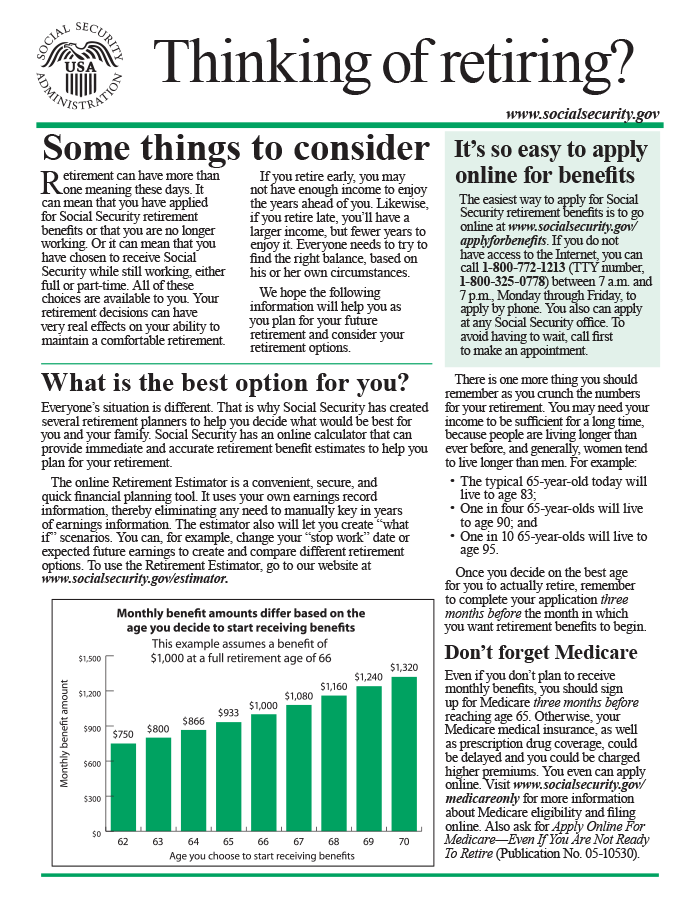
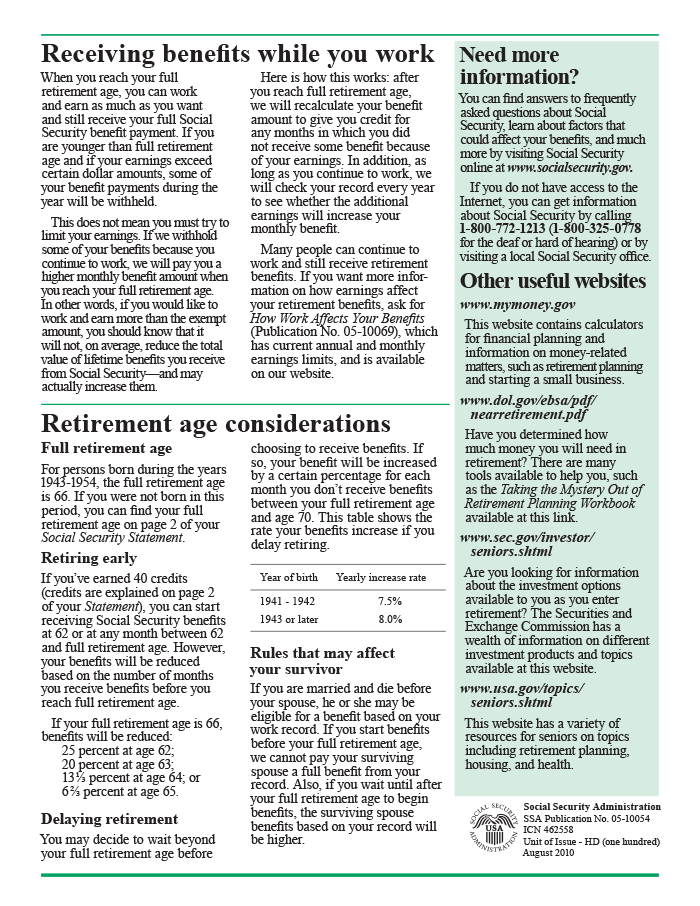
Appendix C
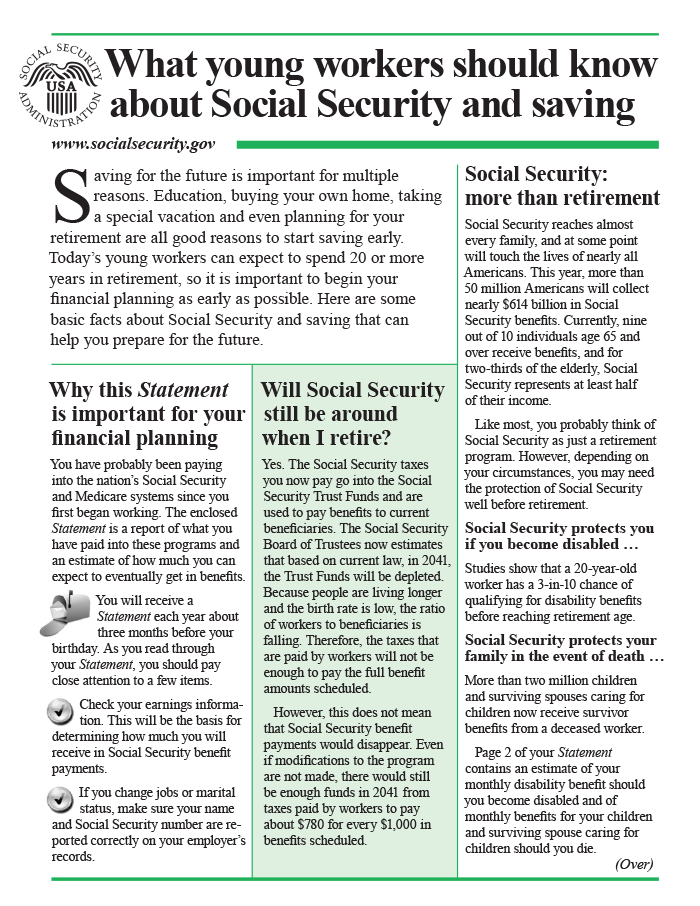
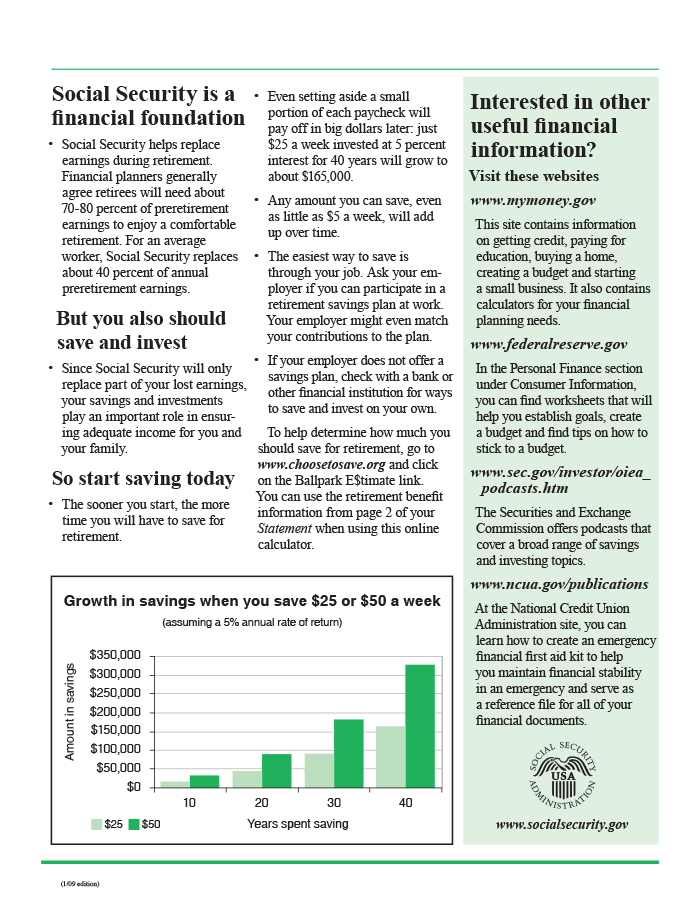
Appendix D
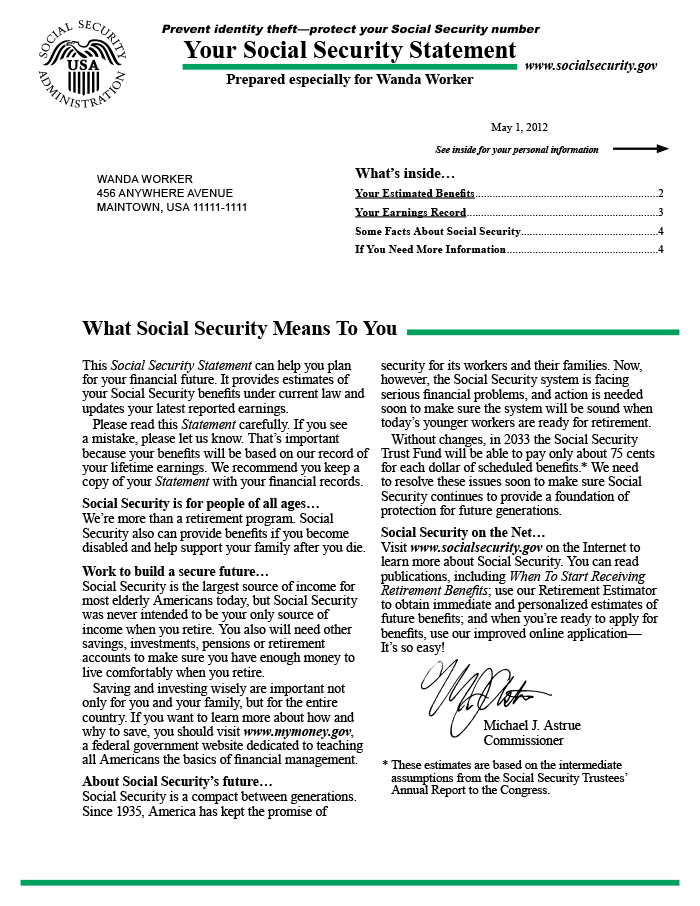
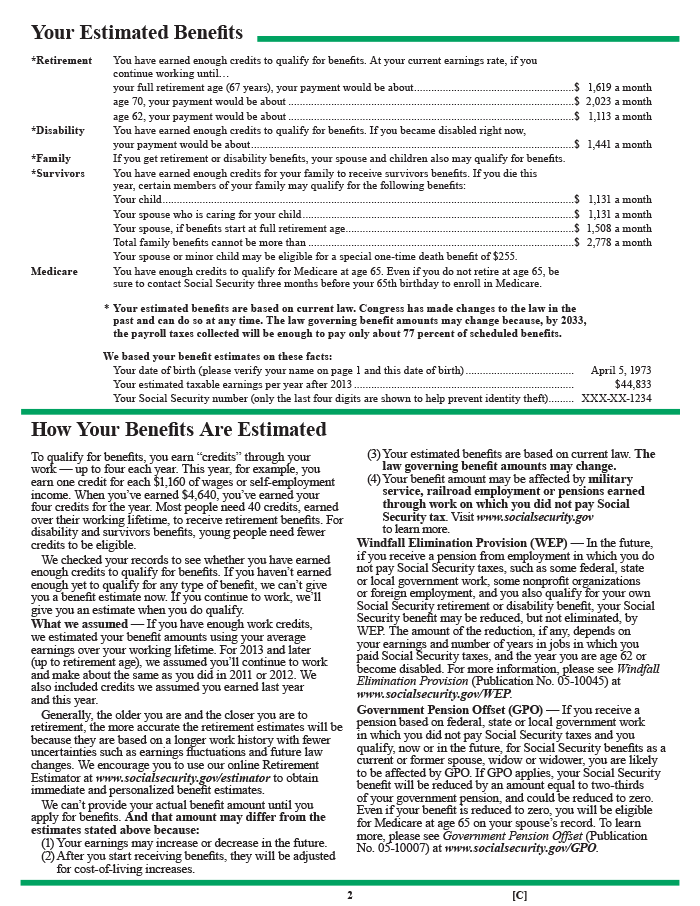
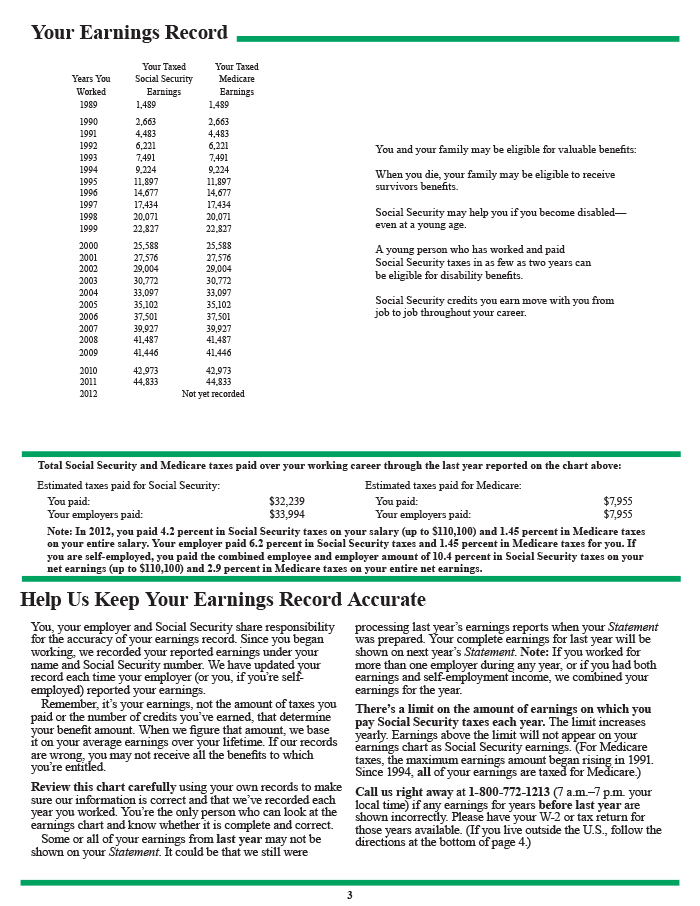
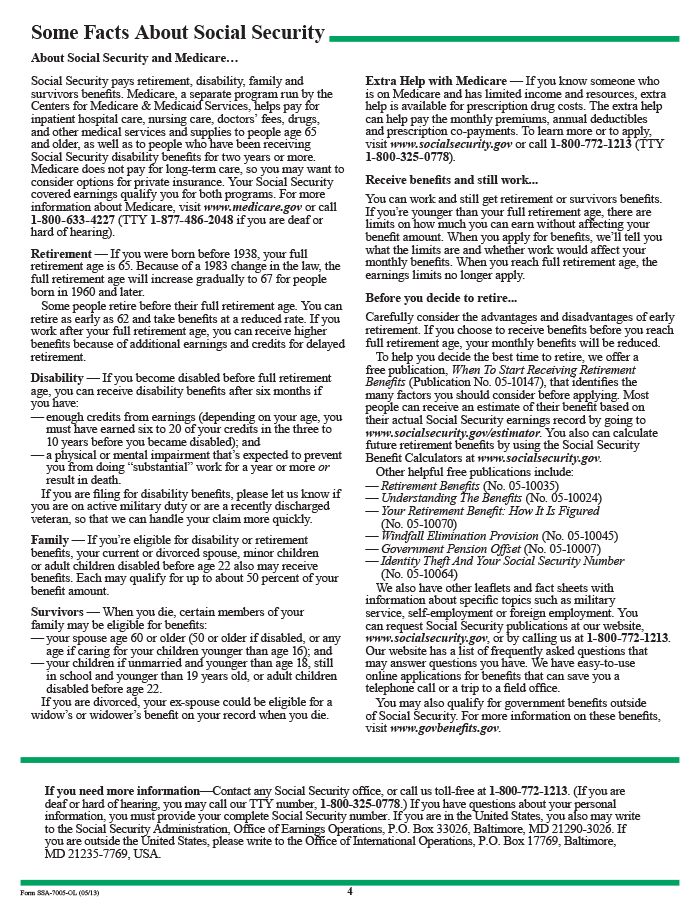
Appendix E
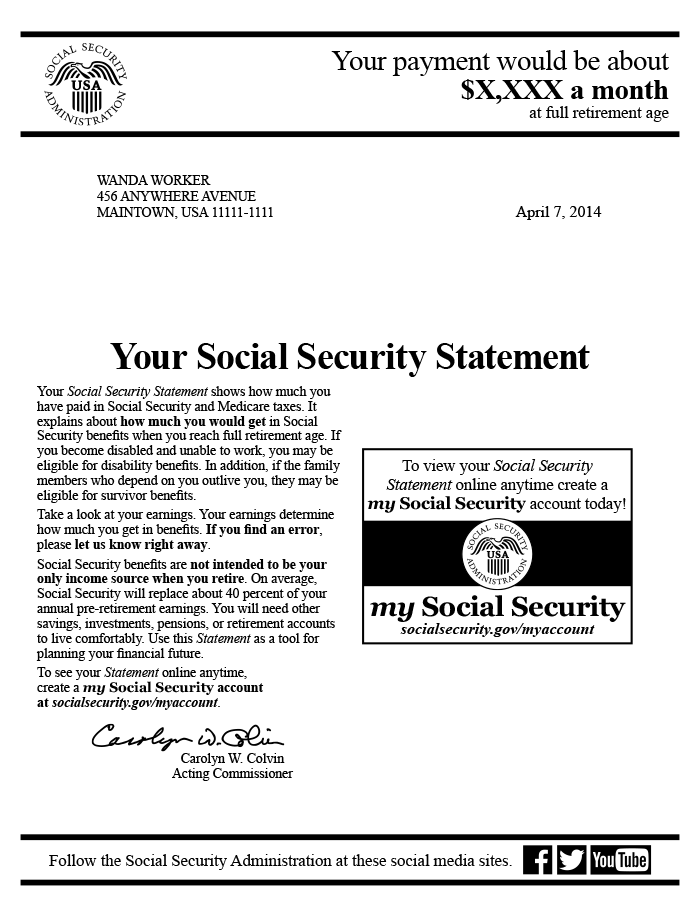
Appendix F
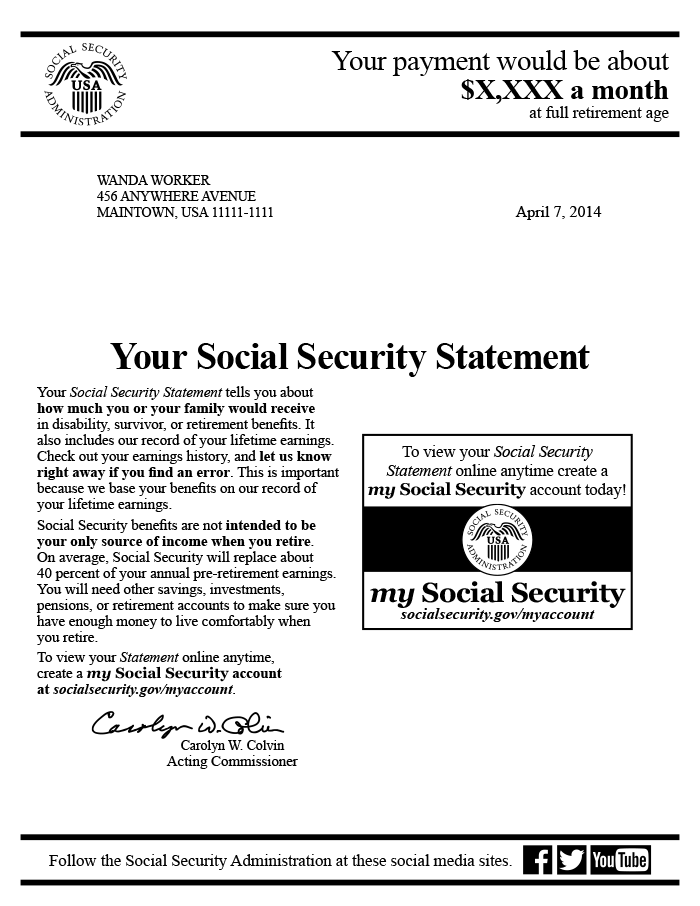
Appendix G
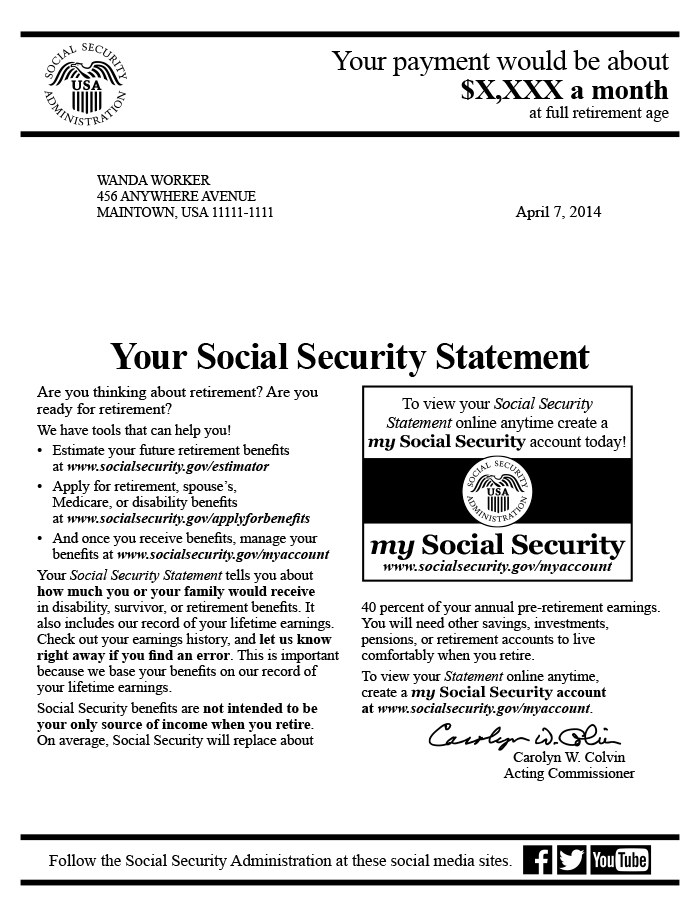
Notes
1 In this article, the capitalized term “Statement” refers exclusively to the Social Security Statement, while “statement” refers generically to both the PEBES and the Social Security Statement.
2 To access his or her online Statement, an individual must create a my Social Security account. Information on creating this account is available at http://www.socialsecurity.gov/mystatement/.
3 The original Social Security Act of 1935 contained no reference to earnings records.
4 The Social Security Board was established by the Social Security Act of 1935 and was composed of three members appointed by the President. In 1946, the SSA, with a single Commissioner, replaced the Board (SSA n.d. b).
5 The National Commission on Social Security is not to be confused with the National Commission on Social Security Reform (informally known as the Greenspan Commission after its Chairman). The latter was appointed by Congress and President Reagan in 1981 and delivered its report in 1983. For additional information on the National Commission on Social Security, see http://www.socialsecurity.gov/history/reports/80commission.html. For additional information on the National Commission on Social Security Reform, see http://www.socialsecurity.gov/history/reports/gspan.html.
6 The report noted that private pension plans were required by the Employee Retirement Income Security Act to provide annual information to all covered employees on their accrued pension benefits, including projected Social Security benefits for those plans closely coordinated with Social Security. Thus, the National Commission on Social Security stated that it was “only reasonable” for SSA to provide similar information.
7 SSA historian Larry DeWitt, e-mail response to third-party query, March 11, 2003.
8 There is disagreement between the Congressional Record, in which Moynihan states that both these events took place on August 4th, and the 2009 Social Security Advisory Board report, which states that SSA began providing statements on August 8th.
9 SSA historian Larry DeWitt, e-mail response to third-party query, March 11, 2003.
10 Eligible individuals were defined as those having a Social Security number, aged 25 or older, and having wages or net earnings from self-employment.
11 Title II of the Social Security Act pertains to Federal Old-Age, Survivors, and Disability Insurance (OASDI) benefits. These are benefits paid to retired or disabled workers and their families, and to the families of deceased workers.
12 OBRA 1990 included a superseding requirement that SSA send the statement annually rather than biennially. It also directed the Internal Revenue Service, upon written request of the SSA commissioner, to provide taxpayer addresses to SSA for use in statement mailings.
13 SSA also considered other options to deal with the large number of mailings that would be required in fiscal year 2000. These options included extending the implementation schedule beyond fiscal year 2000 or sending out statements every 2 or 3 years rather than annually. Because both of these options would have required supporting legislation, SSA instead chose to mail statements to increasingly younger groups of workers in fiscal years 1996–1999 (Enoff n.d.).
14 However, surveys commissioned by SSA in 2008–2010 would find that only 5 percent of statement recipients had ever found an error in the amount of earnings reported.
15 Over the years the 800 number menu has expanded to allow callers to select recorded messages on frequently requested topics—for example, why did I get this statement, where did you get my address, how do I request a new statement, and how do I correct a Social Security card. The SSA website also answers frequently asked questions (SSA n.d. a).
16 As SSA phased in automatic mailing of earnings and benefit statements, it began investigating ways to put PEBES online. Because it was concerned about the privacy risks of using the Internet to transmit personal data, the agency instituted procedures to mitigate these risks. In fall 1996, SSA pretested the online PEBES with a small number of users, who reacted very positively to having online access to their earnings and benefits information. In March 1997, SSA began national testing of its online PEBES. Within days, news media and members of Congress expressed concerns about privacy risks. On April 9, 1997, SSA announced that it was suspending its online PEBES to get advice on how to provide this service while protecting the privacy of personal data. Acting Commissioner John Callahan stated that a more modest and secure version of the online PEBES would be rolled out by the end of the year. This new version would enable individuals to get online estimates of their retirement benefits; however, the underlying information on earnings and tax histories would only be sent by regular mail (Tumin 1998).
17 Preparing and mailing the Statements costs about $70 million a year.
18 The agency based its decision to suspend Statement mailings on determinations by the Department of Justice's Office of Legal Counsel and the Government Accountability Office's Comptroller General that agencies reasonably anticipating a shortfall in their appropriations have both “the authority and duty to curtail or discontinue programs and activities, including activities required by statute” (SSA 2012c).
19 In order to view their online Statements, individuals must provide personal information that matches information already on file with SSA. The agency also uses Experian, an external authentication service provider, for additional verification that includes answering security questions about financial transactions and accounts that Experian has on file. Individuals who, for any reason, cannot complete the verification process may request that SSA mail them a printed Statement or may visit a local Social Security office for help in creating an account and viewing the online Statement.
20 However, these are not necessarily unique visits. Some individuals may have viewed their online Statements multiple times.
21 In July 2013, the agency resumed on-request mailings to those individuals who failed electronic authentication to my Social Security.
22 The act also required SSA to send a modified Statement to noncovered employees describing the potential reduction of Social Security benefits resulting from receipt of a pension from noncovered employment. WEP and GPO, complex and not easily understood provisions, apply to less than 3 percent of Social Security beneficiaries. In 2007, more than 49 million individuals received Social Security benefits, of whom only about 440,000 individuals were affected by GPO and just over 880,000 were affected by WEP (SSAB 2009).
23 Three surveys commissioned by SSA in 2008–2009 showed that between 30 percent and 38 percent of Statement recipients first learned of online claim filing by reading the Statement.
24 Larry DeWitt, e-mail response to third-party query, November 1, 2004. The Office of Information is now the Office of Communications. The Office of Governmental Affairs is now the Office of Legislation and Congressional Affairs. In SSA's current organizational structure, these are two separate and distinct offices.
25 The online Statement also includes links to SSA's online tools for estimating and applying for retirement benefits.
26 This was SSA's second strategic plan. The first was issued in 1988, before legislation mandated PEBES.
27 However, at that time, many recipients would have received their PEBES on request, meaning that they were motivated enough to ask for this information. Individuals aged 47 or older would have received at least one automatically mailed PEBES. Thus, PEBES' true effect is difficult to determine.
28 The questions asked in Gallup's 2003 and 2004 surveys were so different from those in the previous surveys that their results are not comparable to the earlier ones.
References
Chater, Shirley S. 1994. Letter sent to Congress on the PEBES test mailing prior to automatic mailing in 1995.
Department of Health and Human Services. 1991. The Social Security Strategic Plan: A Framework for the Future. Washington, DC: HHS.
Enoff, Louis. No date. “SSA-Initiated Personal Earnings and Benefit Estimates Statements (PEBES).” Internal memorandum.
HHS See Department of Health and Human Services.
[SSA] Social Security Administration. 1994. “Personal Earnings and Benefit Estimate Statements (PEBES): Background and Intent.” Internal memorandum.
———. 1997. Keeping the Promise: Strategic Plan 1997–2002. Publication no. 01-001. Washington, DC: SSA.
———. 2000. Mastering the Challenge: Strategic Plan FY2000–2005. Washington, DC: SSA, Office of Strategic Management.
———. 2008. Strategic Plan: Fiscal Years 2008–2013. Washington, DC: SSA, Office of Strategic Management.
———. 2012a. “One Million People Go Online to Access their Social Security Statement.” Press release. http://www.socialsecurity.gov/pressoffice/pr/ss-statement-pr.html.
———. 2012b. Social Security Administration Performance and Accountability Report, Fiscal Year 2012. SSA Publication No. 31-231. http://www.socialsecurity.gov/finance/fy12_accountability.html.
———. 2012c. Social Security Statement Review, A Report to Congress. http://www.socialsecurity.gov/legislation/SocialSecurityStatementReview2012.pdf.
———. 2012d. “Statement of Michael J. Astrue, Commissioner of Social Security, on the Initial Success of the New Online Social Security Statement.” Press release. http://www.socialsecurity.gov/pressoffice/pr/coss-online-statement-pr.html.
———. 2014. Always Serving/Forward Looking: Our Commitment to the American People. Social Security Administration Agency Strategic Plan Fiscal Years 2014–2018. Washington, DC: SSA, Office of Strategic Planning and Innovation.
———. No date a. Administrative History of SSA 1993–2000. Chapter 7: Public Understanding. http://www.socialsecurity.gov/history/ssa/ssa2000chapter7.html.
———. No date b. Historical Information: Social Security Commissioners. http://www.socialsecurity.gov/history/commissioners.html.
———. No date c. Special Collections: Detailed Chronology, 1940s. http://www.socialsecurity.gov/history/1940.html.
———. No date d. Special Collections: Detailed Chronology, 1960s. http://www.socialsecurity.gov/history/1960.html.
[SSAB] Social Security Advisory Board. 2009. The Social Security Statement: How It Can Be Improved. Washington, DC: SSAB. http://www.ssab.gov/Documents/Social_Security_Statement_Report_2009.pdf.
Tumin, Zachary. 1998. Social Security on the Web: The Case of the Online PEBES. Cambridge, MA: Harvard University, John F. Kennedy School of Government.
U.S. Congress. 1989. 101st Congress, 1st Session. Congressional Record 135, no. 6 (January 25).
———. 2014. 113th Congress, 2nd Session. Congressional Record 160, no. 9 (January 19).